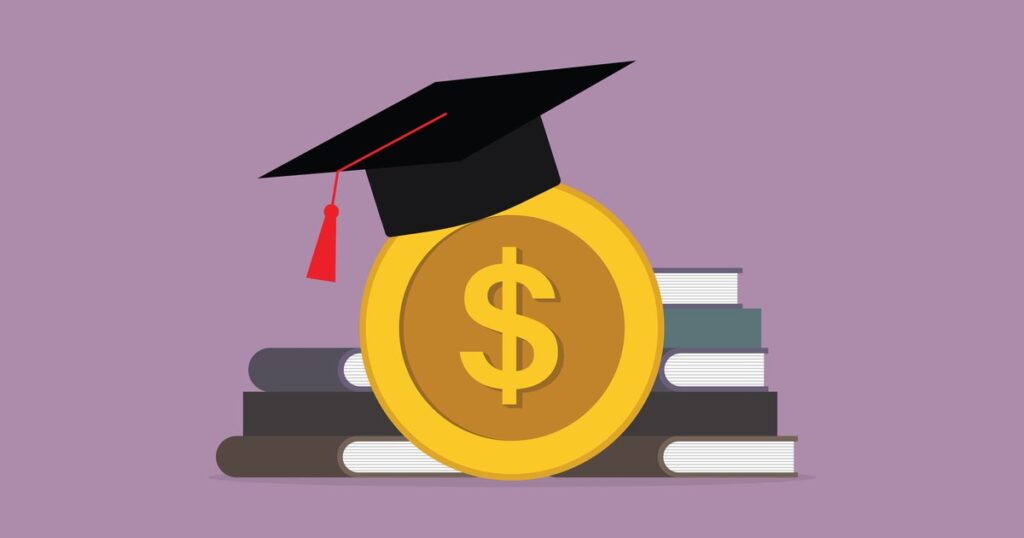As the cost of rent soars, layoffs and joblessness prevail and people quite literally cannot afford to retire, the U.S. Education Department has decided it’s a good time to take away even more of people’s money.
For the first time since the early days of the COVID-19 pandemic in March 2020, the U.S. Education Department will send federal student loans in default to collection, starting May 5.
“As of May 5, borrowers will be subjected to involuntary collections” of their Social Security benefits or tax returns, said Aissa Canchola Bañez, policy director at the Student Borrower Protection Center.
Meaning, money will be taken out of these funds to repay your defaulted student loans. “[Social Security and tax returns] are two of the biggest chunks of benefits right now that could be jeopardized once this process formally restarts,” added Canchola Bañez.
It’s currently unclear whether the May 5 date is when folks will get notices or the day their benefits will be seized by the government, said Canchola Bañez. “We have been pushing for the administration to put out those details because that’s a huge question,” she added.
“And then later this summer is when we understand that folks will start, if they are in default, seeing their wages garnished directly from their paycheck,” Canchola Bañez said, adding, “we don’t know exactly when that is. We have just been told that that will happen, ‘later this summer.’”
And they’ll garnish 15% of your wages, said Natalia Abrams, the president and founder of the Student Debt Crisis Center.
It’s all confusing and vague, so we asked experts for their advice. Here’s what to know:
Here’s how to tell if you have defaulted federal student loans.
Between the Biden administration’s SAVE Plan forbearance, deferred loans and other forms of payment pauses, it’s hard to know if your loans are in default or just on pause.
To be clear, the involuntary wage garnishment and federal benefit deductions only apply to people with federal loans in default, not to those who have a temporary forbearance or who are a few months behind on their loan payments.
According to Canchola Bañez, “over the next two weeks, [the government] will be sending borrowers emails notifying them that they are in default.”
But you don’t have to wait until then to see where your loans stand. You can log into your Federal Student Aid account online and see the status of your loan — whether you’re in default, delinquent, forbearance or current. You can also call your student loan servicer to get this information, but the call wait times are currently very long, said Canchola Bañez.
“This administration is choosing to restart this very callous process at a moment where they know that folks are hurting all over this country.”
– Aissa Canchola Bañez, policy director at the Student Borrower Protection Center
Federal student loans go into default after they are 270 days past due, said Jay Fleischman, a student loan lawyer, but “the Department of Education will not refer the defaulted loan to a debt collector or initiate involuntary collections (like wage garnishment, tax refund offsets) until the loan has been in default for 90 days.”
This is when the government can garnish your wages, take your tax returns, Social Security benefits and any federal monetary benefits, explained Fleischman.
If your loans are currently in default, you have options.
This may all sound pretty grim, especially if you are one of the 5.3 million Americans who have federal loans that are in default, but experts stressed that there are options.
One of which is loan consolidation. “Consolidation is a specific type of refinance, where you take your existing federal student loans, you hand them into the US Department of Education, the US Department of Education pays off those loans and issues you a brand-new what is called a direct consolidation loan, which is a brand-new loan with the exact same balance and the interest of that consolidated loan is a weighted interest of all of the loans that are being paid off through consolidation,” explained Fleischman.
This is a quick and easy option for those who want to get out of default fast. From there, you can elect to have an income-driven repayment plan, said Fleischman, which, hopefully, makes your payment more affordable.
Not everyone qualifies for consolidation, “but that’s one way out of default,” he added.
erhui1979 via Getty Images
Another way to get your loans out of default is rehabilitation, said Fleischman, “which involves coming to an agreement with the debt collector to make nine, what are called reasonable and affordable monthly payments over a 10-month period of time.”
But, this is a 10-month process, so if you’re concerned about wage garnishment or not getting your tax return, consolidation may be the better, faster option, he noted.
You can reach out to the Default Resolution Group to start the rehabilitation process, said Canchola Bañez. “It is important to remember every borrower’s situation is different and we advise folks to do their research to ensure they pursue the best option for their financial situation,” she added.
If you are not in default but can’t afford your loans — or don’t want to pay them — you have a few options.
The best option, if you can afford it, is to repay your student loans to keep them in, or return them to, good standing. But other costs have skyrocketed since the COVID pandemic and lots of people are looking for work, so it’s understandable if you can’t pay.
It’s also understandable if you simply don’t want to pay — lots of people were told their loans were forgiven under the Biden administration just a few years ago, only to have that decision reversed in court. And we’ve seen millions of dollars in PPP loans forgiven for current and former politicians such as Marjorie Taylor Greene and Matt Gaetz, but not for people struggling with student loan payments.
There are lots of people out there saying they’re just not” going to pay their student loans, but Canchola Bañez stressed that you need to be really clear-eyed in what that could mean for you and your finances.
“For borrowers talking about not paying, it does get reported to the credit bureaus after 90 days,” Abrams said.
“It makes it harder for folks to qualify for credit,” said Canchola Bañez. “Borrowers with lower credit scores have to pay higher interest rates, [and] when folks have a lower credit score or are in delinquency or default on their loans, they could struggle to secure housing and other public benefits, and so the economic consequences of falling into delinquency and into default are very severe.”
“If a borrower truly cannot afford to repay their loan, they should explore the possibility of enrolling in an income-driven repayment plan that will drastically reduce their monthly payment.”
– Canchola Bañez
With wage garnishment and the seizing of your federal funds, you don’t want to fall into default and be faced with a smaller paycheck or lower credit score.
“We want to make sure that more folks are not falling into default and delinquency … if we can prevent more people from falling into default and keep their loans in good standing, that is the best thing that we can do,” said Sabrina Calazans, the executive director of the Student Debt Crisis Center.
If you are in default, there are the options we mentioned above. And, if you are not yet in default but are in delinquency or know you can’t afford your loan or want a lower payment, you do have options.
If you are unemployed or have a very low income, you may be able to get a $0 payment with an income-driven repayment plan.
Experts recommend that those who can’t afford their loan payment apply for an income-driven repayment plan. “If a borrower is current on their loans or in delinquency (behind on at least 2 payments, but not yet in default), they can immediately apply for an income-driven repayment plan that could potentially get them a $0 monthly payment,” said Canchola Bañez.
This is not an option, however, for those with defaulted loans.
It’s worth noting that the Department of Education hadn’t been processing repayment plans for the last few months, but it’s expected to resume on May 10, said Abrams.
“If you’re not working, you pay $0 on income-driven repayment plans,” said Abrams. And if you’re very low income, you could also qualify for a $0 payment, said Canchola Bañez.
“And so if a borrower truly cannot afford to repay their loan, they should explore the possibility of enrolling in an income-driven repayment plan that will drastically reduce their monthly payment for some folks as as low as $0,” she explained, “and that is a way that you can continue to stay in good standing on your student loans, while also potentially qualifying for a $0 payment.”
But, once again, the Education Department is not currently processing these income-driven repayment applications, and there is a major backlog.
“Once you submit your application, you will then be put into a processing forbearance, which means you do not have to make payments as your application is processing,” Canchola Bañez said.
Not everyone will be eligible for a $0 payment through an income-driven repayment plan, but they can also lower your monthly payment.
If you can’t afford the lowest monthly payment, you can apply for a forbearance or deferment.
“We also understand that some folks are in the current plan that offers the lowest monthly payment, and so even then, it is very difficult for millions of folks to make their monthly payments,” said Calazans.
“If someone is in that situation and they can’t afford their monthly payment and there is no other option, our recommendation is to apply for a forbearance or a deferment,” she said.
These options temporarily halt your loan payments while keeping your loans in good standing with your loan service provider, but, in most cases, interest continues to accrue, so the balance of your loan will go up.
There are eligibility requirements for both a forbearance and a deferment, but they can keep you from paying your loans for months and even years at a time.
It’s important to understand that choosing one of these options means you do still have to deal with your loans in the future, said Fleischman.
This latest student loan move from the current administration is a cruel one.
If the decision to resume the collection of federal student loans feels cruel, it’s because it is.
“I think what’s frustrating is we find ourselves as a country dealing now with a whole new level of economic uncertainty, and folks are hurting across the board trying to keep up with rising costs of other types of everyday goods — food and gas and rent and childcare and their student loan bills,” said Canchola Bañez.
“And so that’s kind of the extra layer of cruelty here. … this administration is choosing to restart this very callous process at a moment where they know that folks are hurting all over this country, and they’re moving forward regardless,” she said.
And, if this information feels confusing, it’s because it is.
“The system is as transparent as a glass of milk. The system is as simple as a Rubik’s cube to a 4-year-old. That doesn’t mean that there aren’t solutions available,” noted Fleischman.
Read the full article here








